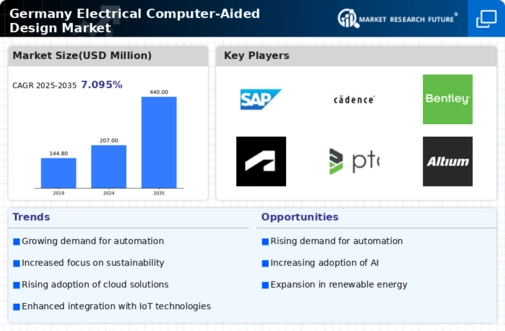The electrical computer-aided-design market in Germany exhibits a dynamic competitive landscape characterized by rapid technological advancements and a growing emphasis on digital transformation. Key players such as Autodesk (US), Siemens (DE), and Dassault Systemes (FR) are at the forefront, each adopting distinct strategies to enhance their market positioning. Autodesk (US) focuses on innovation through cloud-based solutions, aiming to streamline design processes and improve collaboration among users. Siemens (DE), leveraging its strong industrial background, emphasizes integration with IoT technologies, thereby enhancing the functionality of its design tools. Meanwhile, Dassault Systemes (FR) is concentrating on expanding its 3D modeling capabilities, which aligns with the increasing demand for sophisticated design solutions in various sectors. Collectively, these strategies contribute to a competitive environment that is increasingly driven by technological innovation and customer-centric solutions.
In terms of business tactics, companies are increasingly localizing their operations to better serve the German market, optimizing supply chains to enhance efficiency and responsiveness. The market structure appears moderately fragmented, with several key players holding substantial market shares while also facing competition from emerging firms. This fragmentation allows for a diverse range of offerings, catering to various customer needs and preferences, which in turn fosters innovation and competitive pricing.
In October 2025, Autodesk (US) announced a strategic partnership with a leading German engineering firm to develop advanced simulation tools tailored for the automotive sector. This collaboration is expected to enhance Autodesk's product offerings and strengthen its foothold in a critical industry, reflecting a broader trend of partnerships aimed at leveraging local expertise to drive innovation. The strategic importance of this move lies in its potential to accelerate product development cycles and improve the overall quality of design outputs.
In September 2025, Siemens (DE) launched a new version of its design software that integrates AI-driven analytics, aimed at optimizing design workflows for manufacturing processes. This development underscores Siemens' commitment to digital transformation and positions the company to capitalize on the growing demand for intelligent design solutions. The integration of AI not only enhances efficiency but also provides users with actionable insights, thereby improving decision-making processes.
In August 2025, Dassault Systemes (FR) expanded its cloud-based platform to include enhanced collaboration features, facilitating real-time design modifications among teams across different locations. This strategic move is indicative of the increasing importance of remote collaboration tools in the design process, particularly as companies seek to adapt to evolving work environments. By enhancing its platform, Dassault Systemes is likely to attract a broader customer base, particularly among firms prioritizing flexibility and collaboration.
As of November 2025, the competitive trends in the electrical computer-aided-design market are increasingly defined by digitalization, sustainability, and the integration of AI technologies. Strategic alliances are becoming more prevalent, as companies recognize the value of collaboration in driving innovation and enhancing product offerings. Looking ahead, competitive differentiation is expected to evolve, shifting from traditional price-based competition to a focus on technological innovation, supply chain reliability, and the ability to deliver tailored solutions. This transition suggests that companies that prioritize R&D and customer engagement will likely emerge as leaders in this rapidly evolving market.





















Leave a Comment